Clinical Care Plan for Trish Green: Patient Assessment and Management
VerifiedAdded on 2022/11/25
|9
|2503
|261
Report
AI Summary
This report details a clinical care plan developed for Trish Green, a 45-year-old female patient who underwent appendectomy. The plan incorporates ABCDE assessments, clinical judgment, and person-centered care strategies. It identifies acute pain, altered bowel elimination, and risk of infection as priority concerns. The report outlines interventions such as pain management with analgesics and ice packs, promoting bowel movements through mobilization and aperients, and preventing infection through medication and wound care. Evaluation strategies are included to measure the effectiveness of interventions, ensuring patient well-being and recovery. The report also discusses the importance of ongoing assessment of vital signs, activities of daily living, and patient education.
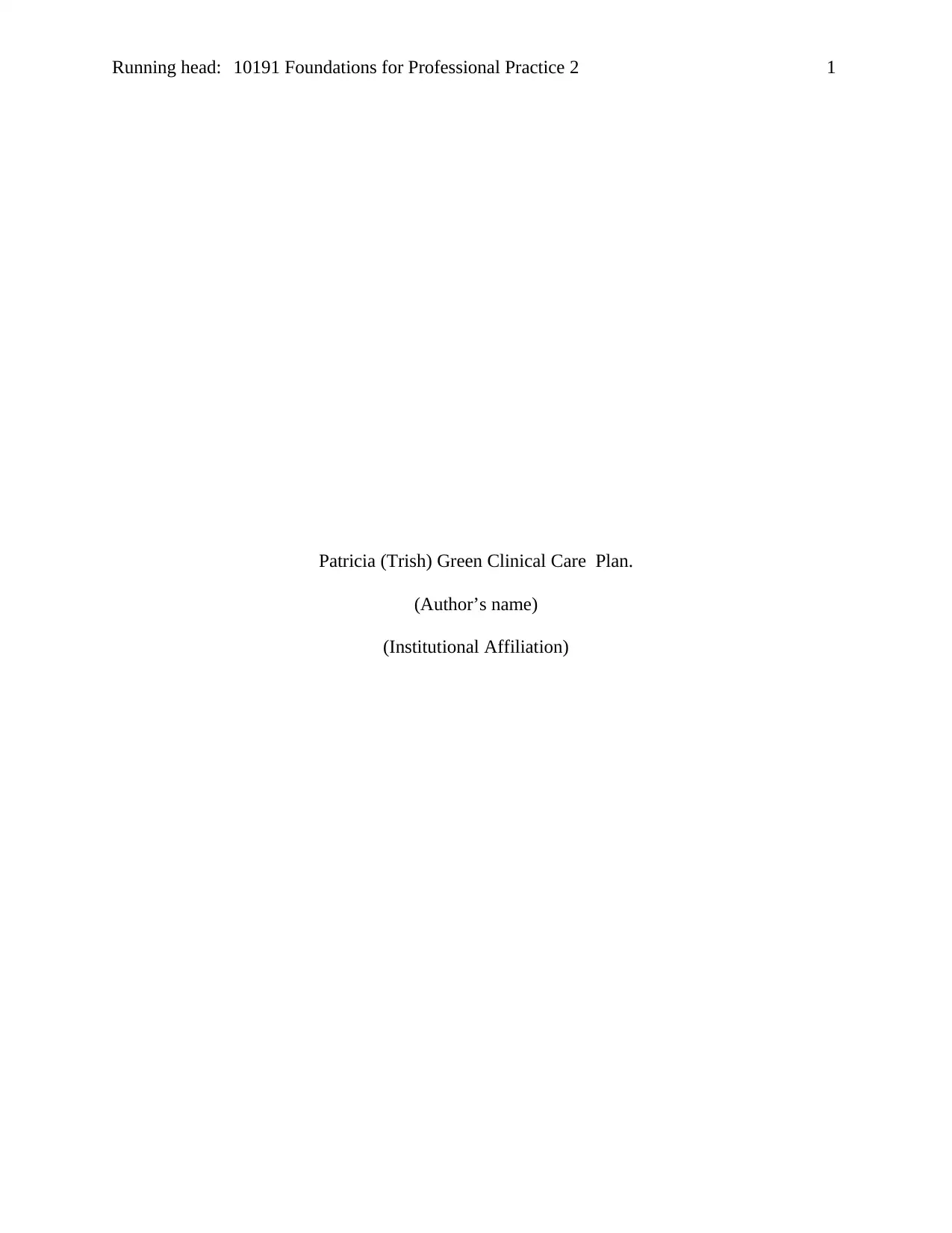
Running head: 10191 Foundations for Professional Practice 2 1
Patricia (Trish) Green Clinical Care Plan.
(Author’s name)
(Institutional Affiliation)
Patricia (Trish) Green Clinical Care Plan.
(Author’s name)
(Institutional Affiliation)
Paraphrase This Document
Need a fresh take? Get an instant paraphrase of this document with our AI Paraphraser
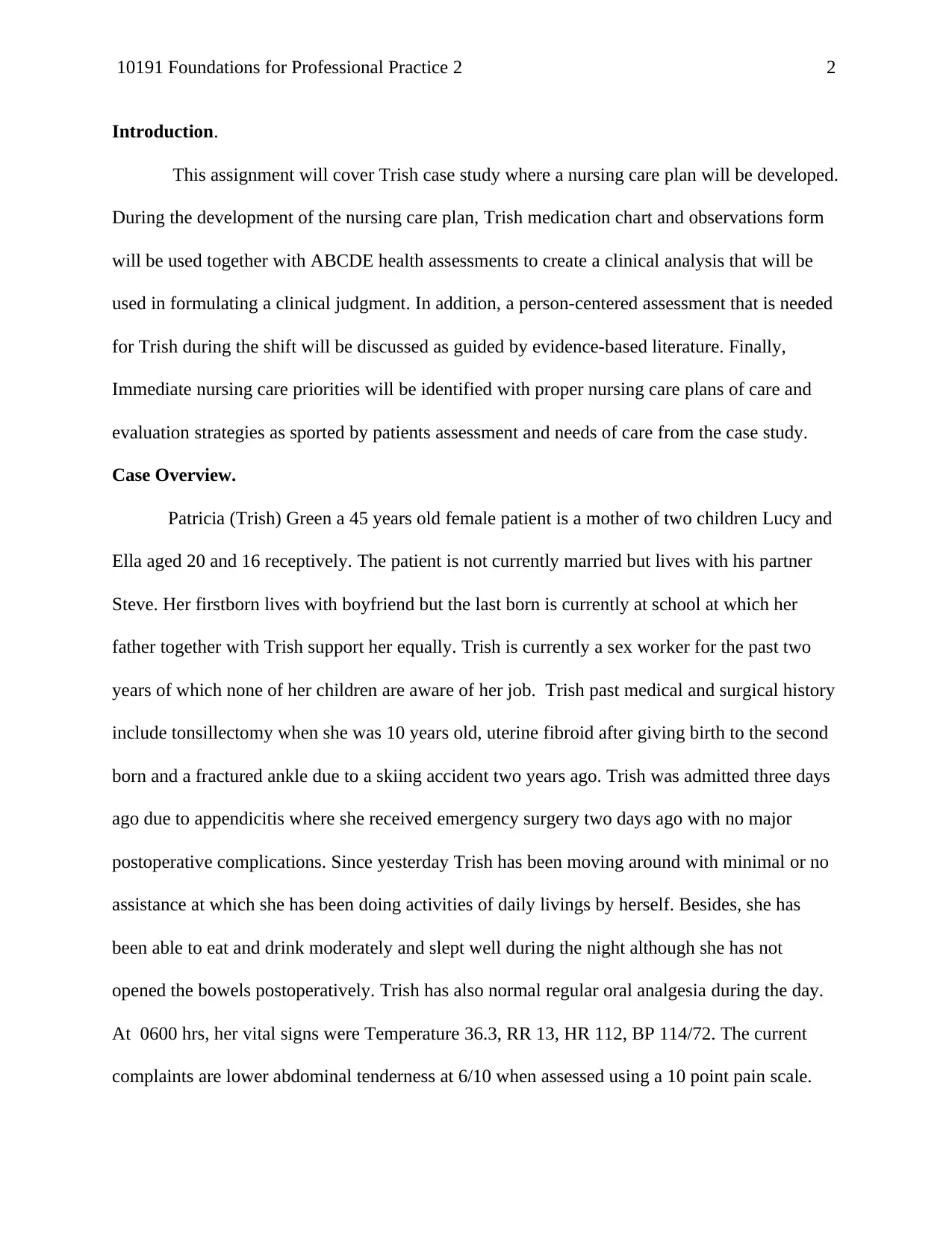
10191 Foundations for Professional Practice 2 2
Introduction.
This assignment will cover Trish case study where a nursing care plan will be developed.
During the development of the nursing care plan, Trish medication chart and observations form
will be used together with ABCDE health assessments to create a clinical analysis that will be
used in formulating a clinical judgment. In addition, a person-centered assessment that is needed
for Trish during the shift will be discussed as guided by evidence-based literature. Finally,
Immediate nursing care priorities will be identified with proper nursing care plans of care and
evaluation strategies as sported by patients assessment and needs of care from the case study.
Case Overview.
Patricia (Trish) Green a 45 years old female patient is a mother of two children Lucy and
Ella aged 20 and 16 receptively. The patient is not currently married but lives with his partner
Steve. Her firstborn lives with boyfriend but the last born is currently at school at which her
father together with Trish support her equally. Trish is currently a sex worker for the past two
years of which none of her children are aware of her job. Trish past medical and surgical history
include tonsillectomy when she was 10 years old, uterine fibroid after giving birth to the second
born and a fractured ankle due to a skiing accident two years ago. Trish was admitted three days
ago due to appendicitis where she received emergency surgery two days ago with no major
postoperative complications. Since yesterday Trish has been moving around with minimal or no
assistance at which she has been doing activities of daily livings by herself. Besides, she has
been able to eat and drink moderately and slept well during the night although she has not
opened the bowels postoperatively. Trish has also normal regular oral analgesia during the day.
At 0600 hrs, her vital signs were Temperature 36.3, RR 13, HR 112, BP 114/72. The current
complaints are lower abdominal tenderness at 6/10 when assessed using a 10 point pain scale.
Introduction.
This assignment will cover Trish case study where a nursing care plan will be developed.
During the development of the nursing care plan, Trish medication chart and observations form
will be used together with ABCDE health assessments to create a clinical analysis that will be
used in formulating a clinical judgment. In addition, a person-centered assessment that is needed
for Trish during the shift will be discussed as guided by evidence-based literature. Finally,
Immediate nursing care priorities will be identified with proper nursing care plans of care and
evaluation strategies as sported by patients assessment and needs of care from the case study.
Case Overview.
Patricia (Trish) Green a 45 years old female patient is a mother of two children Lucy and
Ella aged 20 and 16 receptively. The patient is not currently married but lives with his partner
Steve. Her firstborn lives with boyfriend but the last born is currently at school at which her
father together with Trish support her equally. Trish is currently a sex worker for the past two
years of which none of her children are aware of her job. Trish past medical and surgical history
include tonsillectomy when she was 10 years old, uterine fibroid after giving birth to the second
born and a fractured ankle due to a skiing accident two years ago. Trish was admitted three days
ago due to appendicitis where she received emergency surgery two days ago with no major
postoperative complications. Since yesterday Trish has been moving around with minimal or no
assistance at which she has been doing activities of daily livings by herself. Besides, she has
been able to eat and drink moderately and slept well during the night although she has not
opened the bowels postoperatively. Trish has also normal regular oral analgesia during the day.
At 0600 hrs, her vital signs were Temperature 36.3, RR 13, HR 112, BP 114/72. The current
complaints are lower abdominal tenderness at 6/10 when assessed using a 10 point pain scale.
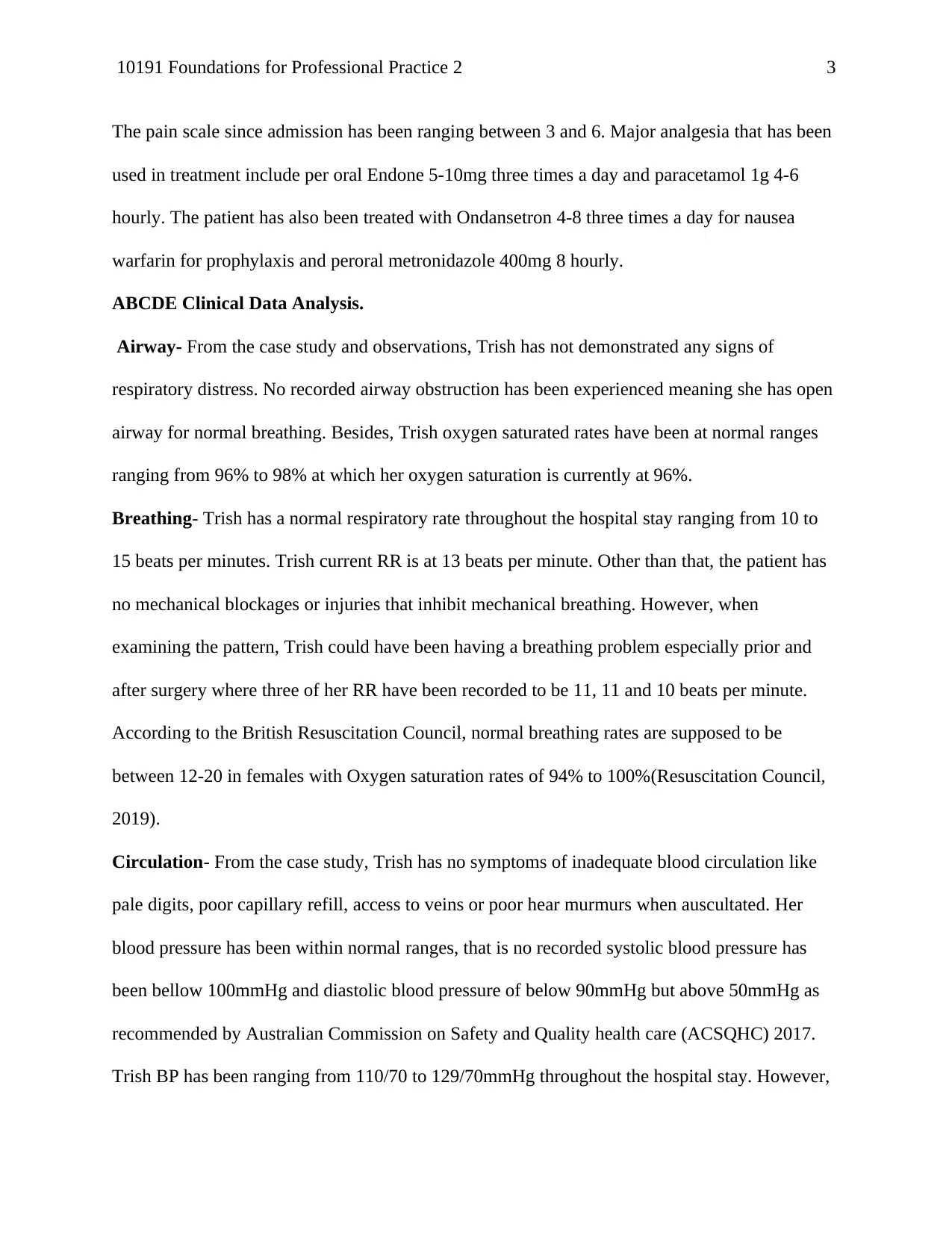
10191 Foundations for Professional Practice 2 3
The pain scale since admission has been ranging between 3 and 6. Major analgesia that has been
used in treatment include per oral Endone 5-10mg three times a day and paracetamol 1g 4-6
hourly. The patient has also been treated with Ondansetron 4-8 three times a day for nausea
warfarin for prophylaxis and peroral metronidazole 400mg 8 hourly.
ABCDE Clinical Data Analysis.
Airway- From the case study and observations, Trish has not demonstrated any signs of
respiratory distress. No recorded airway obstruction has been experienced meaning she has open
airway for normal breathing. Besides, Trish oxygen saturated rates have been at normal ranges
ranging from 96% to 98% at which her oxygen saturation is currently at 96%.
Breathing- Trish has a normal respiratory rate throughout the hospital stay ranging from 10 to
15 beats per minutes. Trish current RR is at 13 beats per minute. Other than that, the patient has
no mechanical blockages or injuries that inhibit mechanical breathing. However, when
examining the pattern, Trish could have been having a breathing problem especially prior and
after surgery where three of her RR have been recorded to be 11, 11 and 10 beats per minute.
According to the British Resuscitation Council, normal breathing rates are supposed to be
between 12-20 in females with Oxygen saturation rates of 94% to 100%(Resuscitation Council,
2019).
Circulation- From the case study, Trish has no symptoms of inadequate blood circulation like
pale digits, poor capillary refill, access to veins or poor hear murmurs when auscultated. Her
blood pressure has been within normal ranges, that is no recorded systolic blood pressure has
been bellow 100mmHg and diastolic blood pressure of below 90mmHg but above 50mmHg as
recommended by Australian Commission on Safety and Quality health care (ACSQHC) 2017.
Trish BP has been ranging from 110/70 to 129/70mmHg throughout the hospital stay. However,
The pain scale since admission has been ranging between 3 and 6. Major analgesia that has been
used in treatment include per oral Endone 5-10mg three times a day and paracetamol 1g 4-6
hourly. The patient has also been treated with Ondansetron 4-8 three times a day for nausea
warfarin for prophylaxis and peroral metronidazole 400mg 8 hourly.
ABCDE Clinical Data Analysis.
Airway- From the case study and observations, Trish has not demonstrated any signs of
respiratory distress. No recorded airway obstruction has been experienced meaning she has open
airway for normal breathing. Besides, Trish oxygen saturated rates have been at normal ranges
ranging from 96% to 98% at which her oxygen saturation is currently at 96%.
Breathing- Trish has a normal respiratory rate throughout the hospital stay ranging from 10 to
15 beats per minutes. Trish current RR is at 13 beats per minute. Other than that, the patient has
no mechanical blockages or injuries that inhibit mechanical breathing. However, when
examining the pattern, Trish could have been having a breathing problem especially prior and
after surgery where three of her RR have been recorded to be 11, 11 and 10 beats per minute.
According to the British Resuscitation Council, normal breathing rates are supposed to be
between 12-20 in females with Oxygen saturation rates of 94% to 100%(Resuscitation Council,
2019).
Circulation- From the case study, Trish has no symptoms of inadequate blood circulation like
pale digits, poor capillary refill, access to veins or poor hear murmurs when auscultated. Her
blood pressure has been within normal ranges, that is no recorded systolic blood pressure has
been bellow 100mmHg and diastolic blood pressure of below 90mmHg but above 50mmHg as
recommended by Australian Commission on Safety and Quality health care (ACSQHC) 2017.
Trish BP has been ranging from 110/70 to 129/70mmHg throughout the hospital stay. However,
⊘ This is a preview!⊘
Do you want full access?
Subscribe today to unlock all pages.

Trusted by 1+ million students worldwide
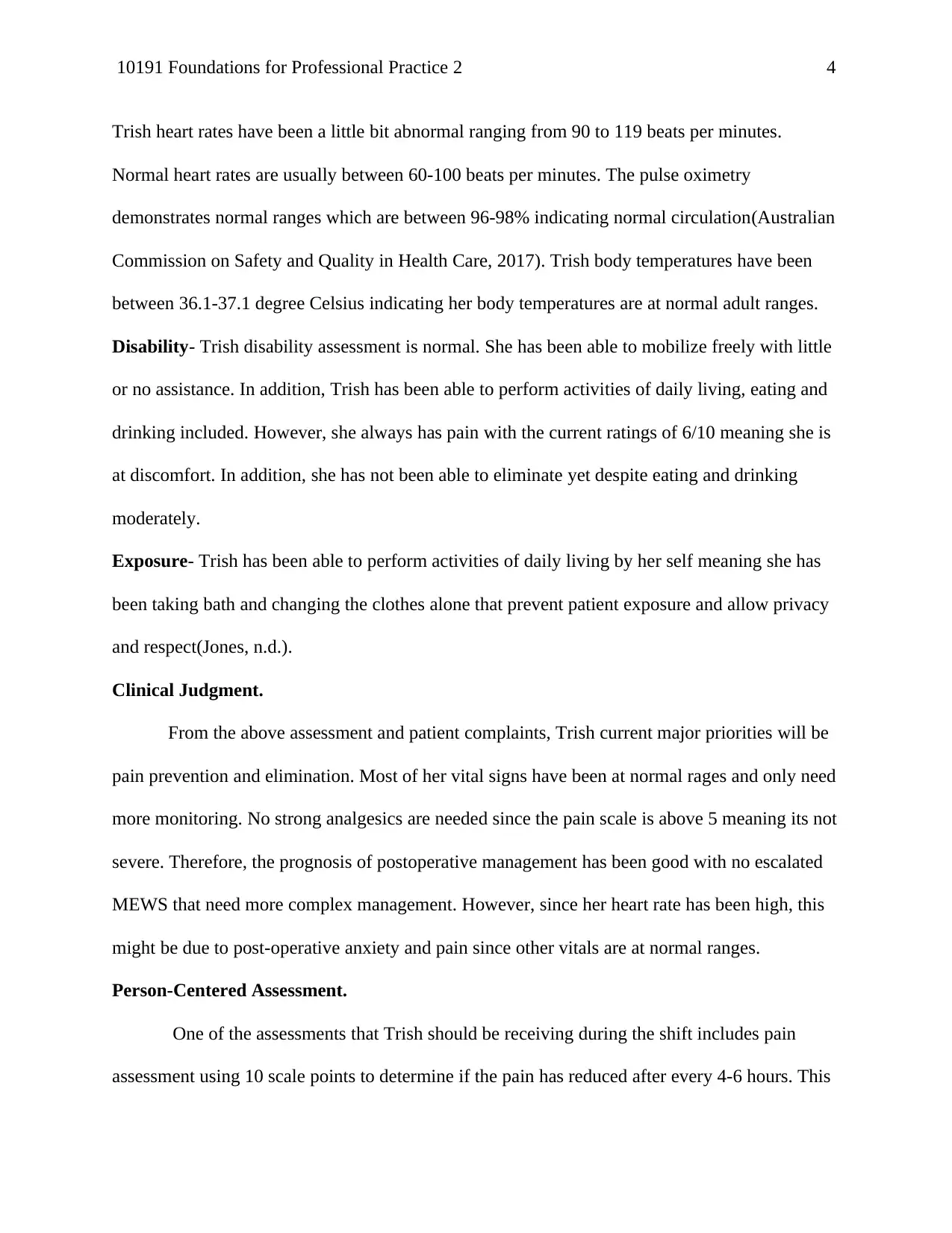
10191 Foundations for Professional Practice 2 4
Trish heart rates have been a little bit abnormal ranging from 90 to 119 beats per minutes.
Normal heart rates are usually between 60-100 beats per minutes. The pulse oximetry
demonstrates normal ranges which are between 96-98% indicating normal circulation(Australian
Commission on Safety and Quality in Health Care, 2017). Trish body temperatures have been
between 36.1-37.1 degree Celsius indicating her body temperatures are at normal adult ranges.
Disability- Trish disability assessment is normal. She has been able to mobilize freely with little
or no assistance. In addition, Trish has been able to perform activities of daily living, eating and
drinking included. However, she always has pain with the current ratings of 6/10 meaning she is
at discomfort. In addition, she has not been able to eliminate yet despite eating and drinking
moderately.
Exposure- Trish has been able to perform activities of daily living by her self meaning she has
been taking bath and changing the clothes alone that prevent patient exposure and allow privacy
and respect(Jones, n.d.).
Clinical Judgment.
From the above assessment and patient complaints, Trish current major priorities will be
pain prevention and elimination. Most of her vital signs have been at normal rages and only need
more monitoring. No strong analgesics are needed since the pain scale is above 5 meaning its not
severe. Therefore, the prognosis of postoperative management has been good with no escalated
MEWS that need more complex management. However, since her heart rate has been high, this
might be due to post-operative anxiety and pain since other vitals are at normal ranges.
Person-Centered Assessment.
One of the assessments that Trish should be receiving during the shift includes pain
assessment using 10 scale points to determine if the pain has reduced after every 4-6 hours. This
Trish heart rates have been a little bit abnormal ranging from 90 to 119 beats per minutes.
Normal heart rates are usually between 60-100 beats per minutes. The pulse oximetry
demonstrates normal ranges which are between 96-98% indicating normal circulation(Australian
Commission on Safety and Quality in Health Care, 2017). Trish body temperatures have been
between 36.1-37.1 degree Celsius indicating her body temperatures are at normal adult ranges.
Disability- Trish disability assessment is normal. She has been able to mobilize freely with little
or no assistance. In addition, Trish has been able to perform activities of daily living, eating and
drinking included. However, she always has pain with the current ratings of 6/10 meaning she is
at discomfort. In addition, she has not been able to eliminate yet despite eating and drinking
moderately.
Exposure- Trish has been able to perform activities of daily living by her self meaning she has
been taking bath and changing the clothes alone that prevent patient exposure and allow privacy
and respect(Jones, n.d.).
Clinical Judgment.
From the above assessment and patient complaints, Trish current major priorities will be
pain prevention and elimination. Most of her vital signs have been at normal rages and only need
more monitoring. No strong analgesics are needed since the pain scale is above 5 meaning its not
severe. Therefore, the prognosis of postoperative management has been good with no escalated
MEWS that need more complex management. However, since her heart rate has been high, this
might be due to post-operative anxiety and pain since other vitals are at normal ranges.
Person-Centered Assessment.
One of the assessments that Trish should be receiving during the shift includes pain
assessment using 10 scale points to determine if the pain has reduced after every 4-6 hours. This
Paraphrase This Document
Need a fresh take? Get an instant paraphrase of this document with our AI Paraphraser
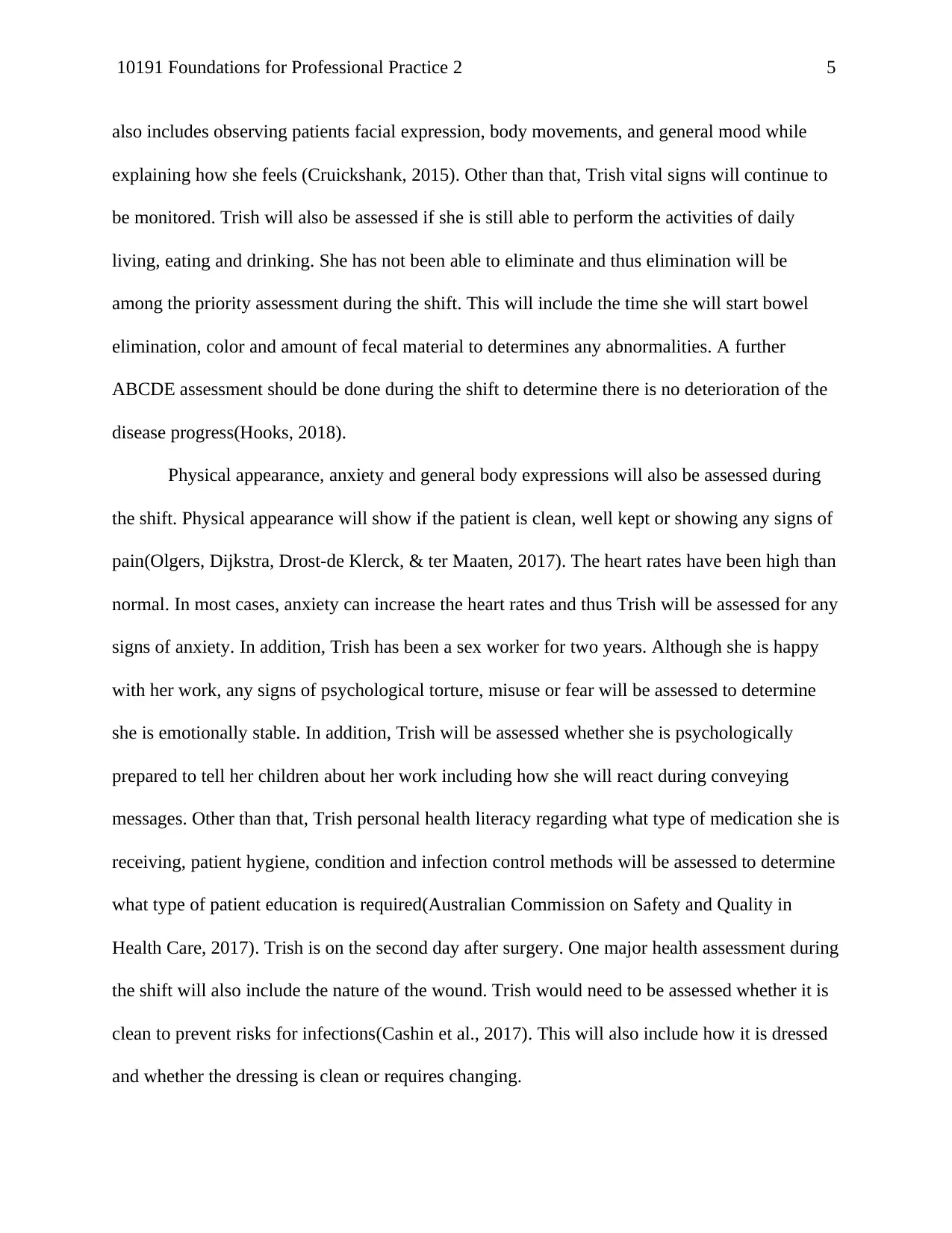
10191 Foundations for Professional Practice 2 5
also includes observing patients facial expression, body movements, and general mood while
explaining how she feels (Cruickshank, 2015). Other than that, Trish vital signs will continue to
be monitored. Trish will also be assessed if she is still able to perform the activities of daily
living, eating and drinking. She has not been able to eliminate and thus elimination will be
among the priority assessment during the shift. This will include the time she will start bowel
elimination, color and amount of fecal material to determines any abnormalities. A further
ABCDE assessment should be done during the shift to determine there is no deterioration of the
disease progress(Hooks, 2018).
Physical appearance, anxiety and general body expressions will also be assessed during
the shift. Physical appearance will show if the patient is clean, well kept or showing any signs of
pain(Olgers, Dijkstra, Drost-de Klerck, & ter Maaten, 2017). The heart rates have been high than
normal. In most cases, anxiety can increase the heart rates and thus Trish will be assessed for any
signs of anxiety. In addition, Trish has been a sex worker for two years. Although she is happy
with her work, any signs of psychological torture, misuse or fear will be assessed to determine
she is emotionally stable. In addition, Trish will be assessed whether she is psychologically
prepared to tell her children about her work including how she will react during conveying
messages. Other than that, Trish personal health literacy regarding what type of medication she is
receiving, patient hygiene, condition and infection control methods will be assessed to determine
what type of patient education is required(Australian Commission on Safety and Quality in
Health Care, 2017). Trish is on the second day after surgery. One major health assessment during
the shift will also include the nature of the wound. Trish would need to be assessed whether it is
clean to prevent risks for infections(Cashin et al., 2017). This will also include how it is dressed
and whether the dressing is clean or requires changing.
also includes observing patients facial expression, body movements, and general mood while
explaining how she feels (Cruickshank, 2015). Other than that, Trish vital signs will continue to
be monitored. Trish will also be assessed if she is still able to perform the activities of daily
living, eating and drinking. She has not been able to eliminate and thus elimination will be
among the priority assessment during the shift. This will include the time she will start bowel
elimination, color and amount of fecal material to determines any abnormalities. A further
ABCDE assessment should be done during the shift to determine there is no deterioration of the
disease progress(Hooks, 2018).
Physical appearance, anxiety and general body expressions will also be assessed during
the shift. Physical appearance will show if the patient is clean, well kept or showing any signs of
pain(Olgers, Dijkstra, Drost-de Klerck, & ter Maaten, 2017). The heart rates have been high than
normal. In most cases, anxiety can increase the heart rates and thus Trish will be assessed for any
signs of anxiety. In addition, Trish has been a sex worker for two years. Although she is happy
with her work, any signs of psychological torture, misuse or fear will be assessed to determine
she is emotionally stable. In addition, Trish will be assessed whether she is psychologically
prepared to tell her children about her work including how she will react during conveying
messages. Other than that, Trish personal health literacy regarding what type of medication she is
receiving, patient hygiene, condition and infection control methods will be assessed to determine
what type of patient education is required(Australian Commission on Safety and Quality in
Health Care, 2017). Trish is on the second day after surgery. One major health assessment during
the shift will also include the nature of the wound. Trish would need to be assessed whether it is
clean to prevent risks for infections(Cashin et al., 2017). This will also include how it is dressed
and whether the dressing is clean or requires changing.
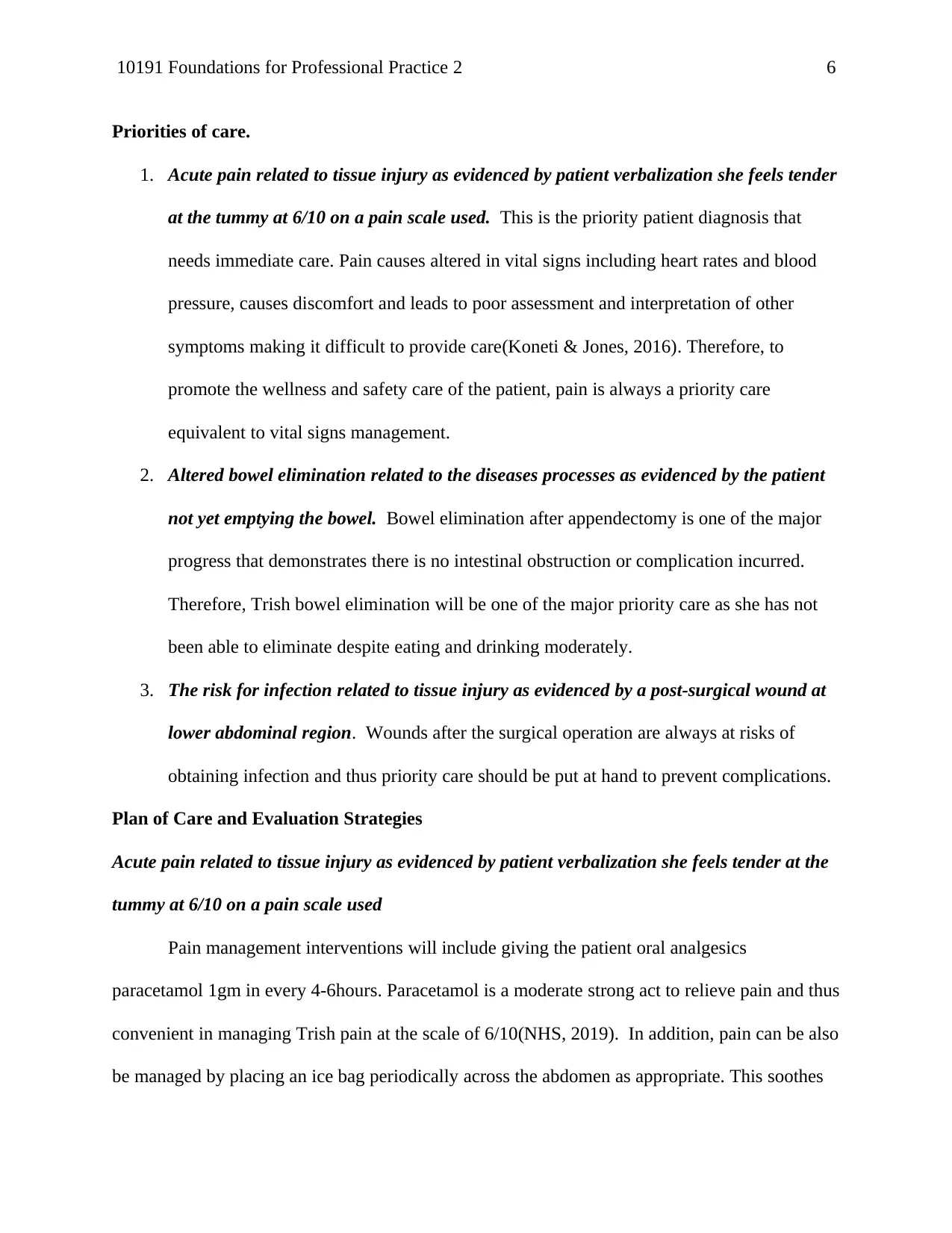
10191 Foundations for Professional Practice 2 6
Priorities of care.
1. Acute pain related to tissue injury as evidenced by patient verbalization she feels tender
at the tummy at 6/10 on a pain scale used. This is the priority patient diagnosis that
needs immediate care. Pain causes altered in vital signs including heart rates and blood
pressure, causes discomfort and leads to poor assessment and interpretation of other
symptoms making it difficult to provide care(Koneti & Jones, 2016). Therefore, to
promote the wellness and safety care of the patient, pain is always a priority care
equivalent to vital signs management.
2. Altered bowel elimination related to the diseases processes as evidenced by the patient
not yet emptying the bowel. Bowel elimination after appendectomy is one of the major
progress that demonstrates there is no intestinal obstruction or complication incurred.
Therefore, Trish bowel elimination will be one of the major priority care as she has not
been able to eliminate despite eating and drinking moderately.
3. The risk for infection related to tissue injury as evidenced by a post-surgical wound at
lower abdominal region. Wounds after the surgical operation are always at risks of
obtaining infection and thus priority care should be put at hand to prevent complications.
Plan of Care and Evaluation Strategies
Acute pain related to tissue injury as evidenced by patient verbalization she feels tender at the
tummy at 6/10 on a pain scale used
Pain management interventions will include giving the patient oral analgesics
paracetamol 1gm in every 4-6hours. Paracetamol is a moderate strong act to relieve pain and thus
convenient in managing Trish pain at the scale of 6/10(NHS, 2019). In addition, pain can be also
be managed by placing an ice bag periodically across the abdomen as appropriate. This soothes
Priorities of care.
1. Acute pain related to tissue injury as evidenced by patient verbalization she feels tender
at the tummy at 6/10 on a pain scale used. This is the priority patient diagnosis that
needs immediate care. Pain causes altered in vital signs including heart rates and blood
pressure, causes discomfort and leads to poor assessment and interpretation of other
symptoms making it difficult to provide care(Koneti & Jones, 2016). Therefore, to
promote the wellness and safety care of the patient, pain is always a priority care
equivalent to vital signs management.
2. Altered bowel elimination related to the diseases processes as evidenced by the patient
not yet emptying the bowel. Bowel elimination after appendectomy is one of the major
progress that demonstrates there is no intestinal obstruction or complication incurred.
Therefore, Trish bowel elimination will be one of the major priority care as she has not
been able to eliminate despite eating and drinking moderately.
3. The risk for infection related to tissue injury as evidenced by a post-surgical wound at
lower abdominal region. Wounds after the surgical operation are always at risks of
obtaining infection and thus priority care should be put at hand to prevent complications.
Plan of Care and Evaluation Strategies
Acute pain related to tissue injury as evidenced by patient verbalization she feels tender at the
tummy at 6/10 on a pain scale used
Pain management interventions will include giving the patient oral analgesics
paracetamol 1gm in every 4-6hours. Paracetamol is a moderate strong act to relieve pain and thus
convenient in managing Trish pain at the scale of 6/10(NHS, 2019). In addition, pain can be also
be managed by placing an ice bag periodically across the abdomen as appropriate. This soothes
⊘ This is a preview!⊘
Do you want full access?
Subscribe today to unlock all pages.

Trusted by 1+ million students worldwide
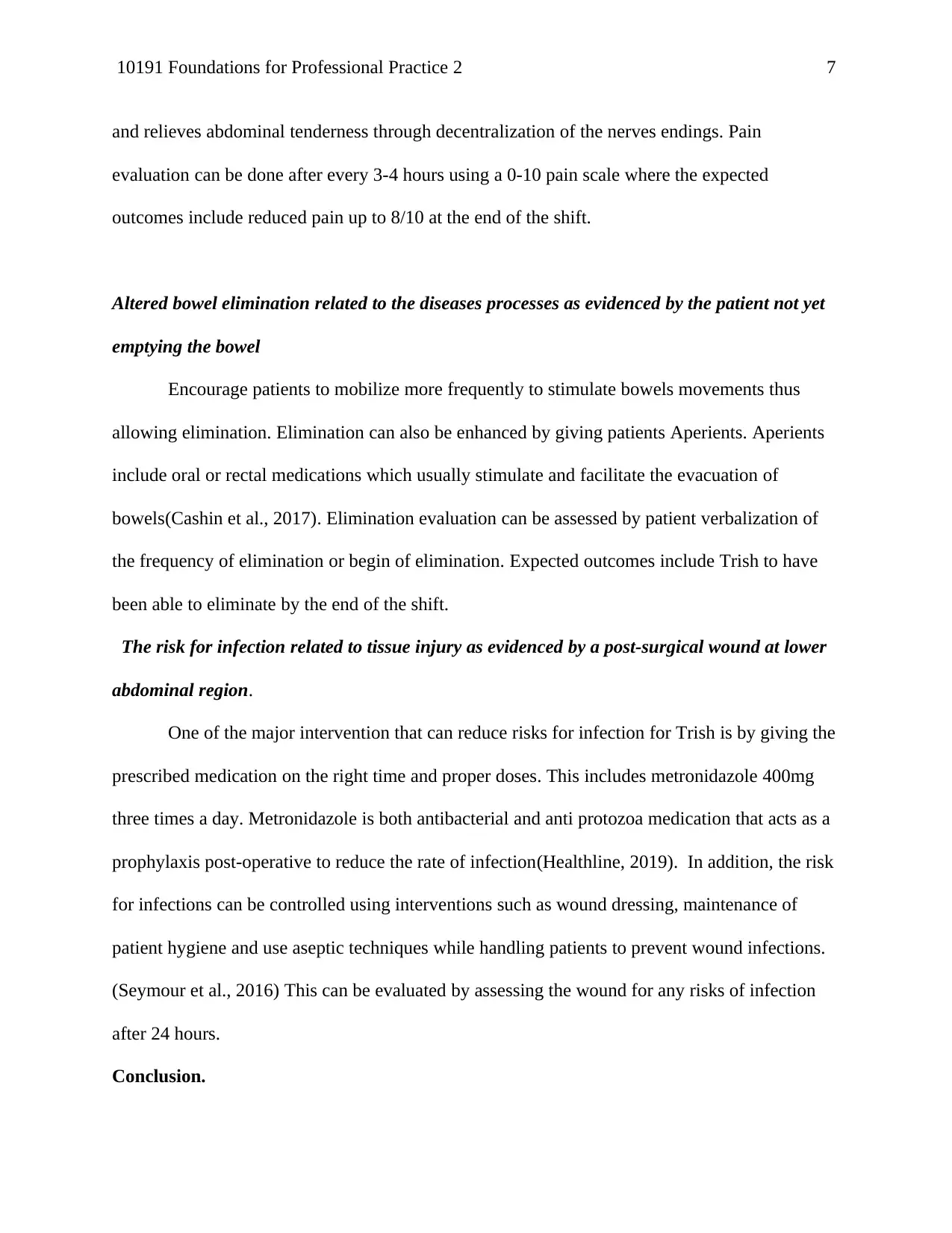
10191 Foundations for Professional Practice 2 7
and relieves abdominal tenderness through decentralization of the nerves endings. Pain
evaluation can be done after every 3-4 hours using a 0-10 pain scale where the expected
outcomes include reduced pain up to 8/10 at the end of the shift.
Altered bowel elimination related to the diseases processes as evidenced by the patient not yet
emptying the bowel
Encourage patients to mobilize more frequently to stimulate bowels movements thus
allowing elimination. Elimination can also be enhanced by giving patients Aperients. Aperients
include oral or rectal medications which usually stimulate and facilitate the evacuation of
bowels(Cashin et al., 2017). Elimination evaluation can be assessed by patient verbalization of
the frequency of elimination or begin of elimination. Expected outcomes include Trish to have
been able to eliminate by the end of the shift.
The risk for infection related to tissue injury as evidenced by a post-surgical wound at lower
abdominal region.
One of the major intervention that can reduce risks for infection for Trish is by giving the
prescribed medication on the right time and proper doses. This includes metronidazole 400mg
three times a day. Metronidazole is both antibacterial and anti protozoa medication that acts as a
prophylaxis post-operative to reduce the rate of infection(Healthline, 2019). In addition, the risk
for infections can be controlled using interventions such as wound dressing, maintenance of
patient hygiene and use aseptic techniques while handling patients to prevent wound infections.
(Seymour et al., 2016) This can be evaluated by assessing the wound for any risks of infection
after 24 hours.
Conclusion.
and relieves abdominal tenderness through decentralization of the nerves endings. Pain
evaluation can be done after every 3-4 hours using a 0-10 pain scale where the expected
outcomes include reduced pain up to 8/10 at the end of the shift.
Altered bowel elimination related to the diseases processes as evidenced by the patient not yet
emptying the bowel
Encourage patients to mobilize more frequently to stimulate bowels movements thus
allowing elimination. Elimination can also be enhanced by giving patients Aperients. Aperients
include oral or rectal medications which usually stimulate and facilitate the evacuation of
bowels(Cashin et al., 2017). Elimination evaluation can be assessed by patient verbalization of
the frequency of elimination or begin of elimination. Expected outcomes include Trish to have
been able to eliminate by the end of the shift.
The risk for infection related to tissue injury as evidenced by a post-surgical wound at lower
abdominal region.
One of the major intervention that can reduce risks for infection for Trish is by giving the
prescribed medication on the right time and proper doses. This includes metronidazole 400mg
three times a day. Metronidazole is both antibacterial and anti protozoa medication that acts as a
prophylaxis post-operative to reduce the rate of infection(Healthline, 2019). In addition, the risk
for infections can be controlled using interventions such as wound dressing, maintenance of
patient hygiene and use aseptic techniques while handling patients to prevent wound infections.
(Seymour et al., 2016) This can be evaluated by assessing the wound for any risks of infection
after 24 hours.
Conclusion.
Paraphrase This Document
Need a fresh take? Get an instant paraphrase of this document with our AI Paraphraser
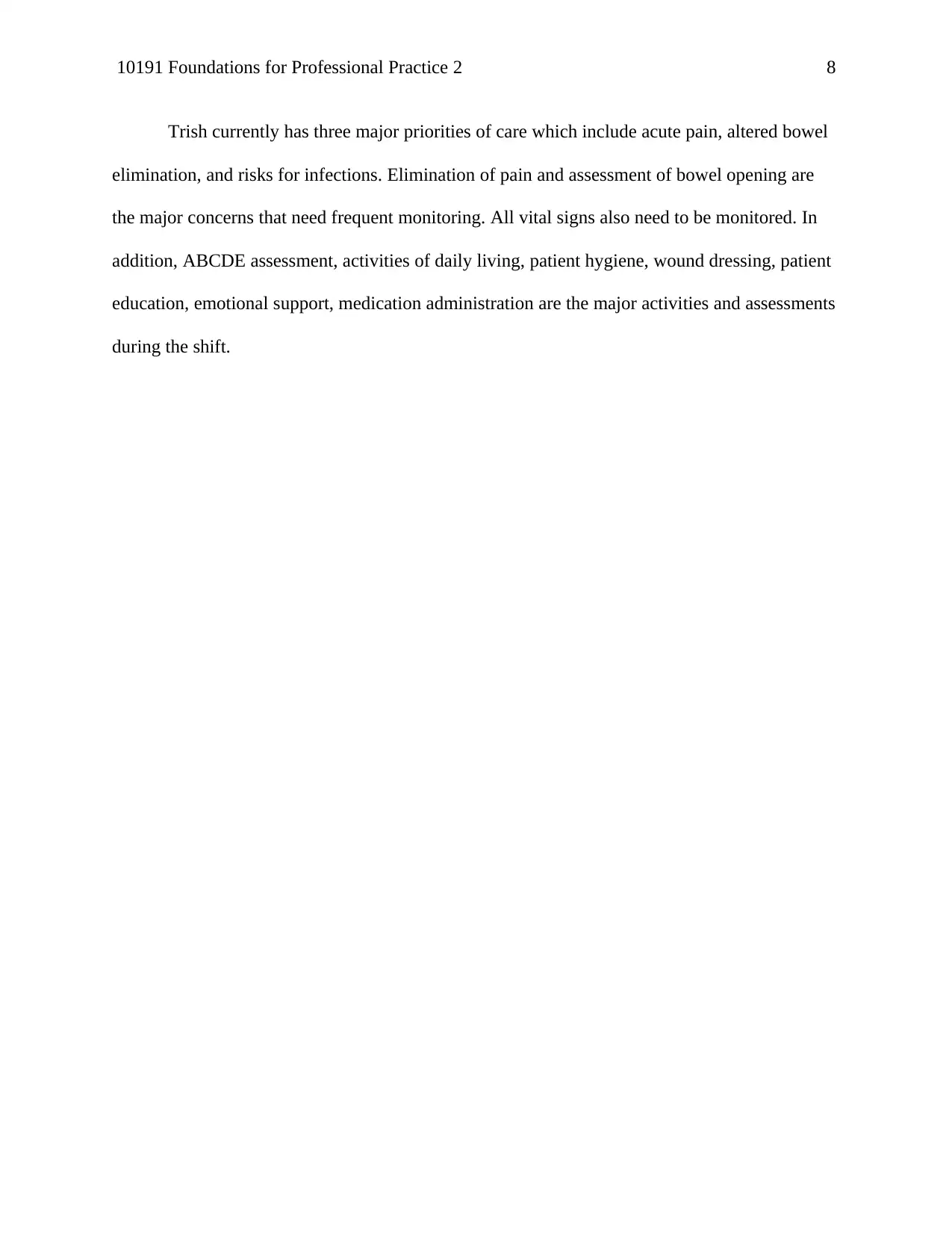
10191 Foundations for Professional Practice 2 8
Trish currently has three major priorities of care which include acute pain, altered bowel
elimination, and risks for infections. Elimination of pain and assessment of bowel opening are
the major concerns that need frequent monitoring. All vital signs also need to be monitored. In
addition, ABCDE assessment, activities of daily living, patient hygiene, wound dressing, patient
education, emotional support, medication administration are the major activities and assessments
during the shift.
Trish currently has three major priorities of care which include acute pain, altered bowel
elimination, and risks for infections. Elimination of pain and assessment of bowel opening are
the major concerns that need frequent monitoring. All vital signs also need to be monitored. In
addition, ABCDE assessment, activities of daily living, patient hygiene, wound dressing, patient
education, emotional support, medication administration are the major activities and assessments
during the shift.
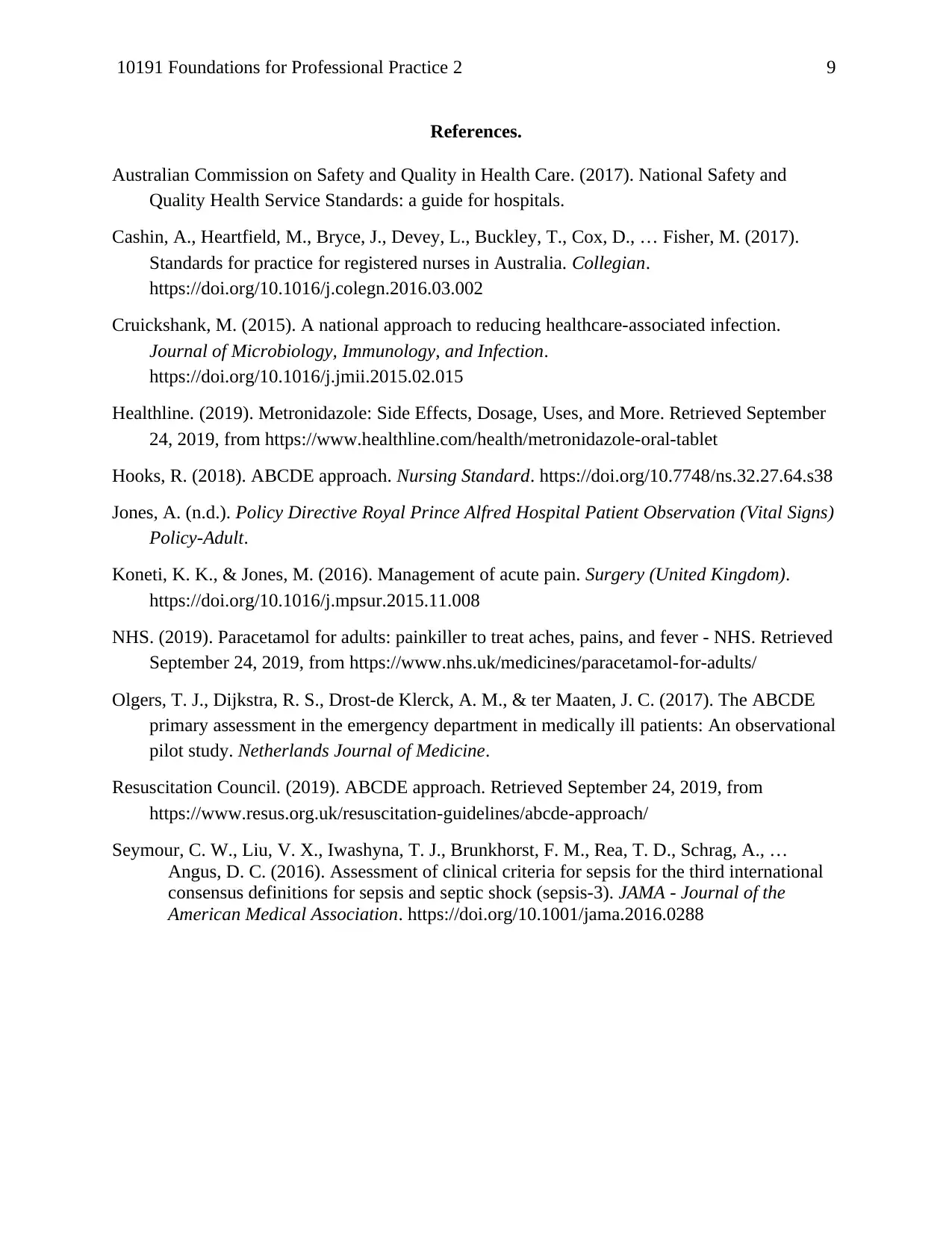
10191 Foundations for Professional Practice 2 9
References.
Australian Commission on Safety and Quality in Health Care. (2017). National Safety and
Quality Health Service Standards: a guide for hospitals.
Cashin, A., Heartfield, M., Bryce, J., Devey, L., Buckley, T., Cox, D., … Fisher, M. (2017).
Standards for practice for registered nurses in Australia. Collegian.
https://doi.org/10.1016/j.colegn.2016.03.002
Cruickshank, M. (2015). A national approach to reducing healthcare-associated infection.
Journal of Microbiology, Immunology, and Infection.
https://doi.org/10.1016/j.jmii.2015.02.015
Healthline. (2019). Metronidazole: Side Effects, Dosage, Uses, and More. Retrieved September
24, 2019, from https://www.healthline.com/health/metronidazole-oral-tablet
Hooks, R. (2018). ABCDE approach. Nursing Standard. https://doi.org/10.7748/ns.32.27.64.s38
Jones, A. (n.d.). Policy Directive Royal Prince Alfred Hospital Patient Observation (Vital Signs)
Policy-Adult.
Koneti, K. K., & Jones, M. (2016). Management of acute pain. Surgery (United Kingdom).
https://doi.org/10.1016/j.mpsur.2015.11.008
NHS. (2019). Paracetamol for adults: painkiller to treat aches, pains, and fever - NHS. Retrieved
September 24, 2019, from https://www.nhs.uk/medicines/paracetamol-for-adults/
Olgers, T. J., Dijkstra, R. S., Drost-de Klerck, A. M., & ter Maaten, J. C. (2017). The ABCDE
primary assessment in the emergency department in medically ill patients: An observational
pilot study. Netherlands Journal of Medicine.
Resuscitation Council. (2019). ABCDE approach. Retrieved September 24, 2019, from
https://www.resus.org.uk/resuscitation-guidelines/abcde-approach/
Seymour, C. W., Liu, V. X., Iwashyna, T. J., Brunkhorst, F. M., Rea, T. D., Schrag, A., …
Angus, D. C. (2016). Assessment of clinical criteria for sepsis for the third international
consensus definitions for sepsis and septic shock (sepsis-3). JAMA - Journal of the
American Medical Association. https://doi.org/10.1001/jama.2016.0288
References.
Australian Commission on Safety and Quality in Health Care. (2017). National Safety and
Quality Health Service Standards: a guide for hospitals.
Cashin, A., Heartfield, M., Bryce, J., Devey, L., Buckley, T., Cox, D., … Fisher, M. (2017).
Standards for practice for registered nurses in Australia. Collegian.
https://doi.org/10.1016/j.colegn.2016.03.002
Cruickshank, M. (2015). A national approach to reducing healthcare-associated infection.
Journal of Microbiology, Immunology, and Infection.
https://doi.org/10.1016/j.jmii.2015.02.015
Healthline. (2019). Metronidazole: Side Effects, Dosage, Uses, and More. Retrieved September
24, 2019, from https://www.healthline.com/health/metronidazole-oral-tablet
Hooks, R. (2018). ABCDE approach. Nursing Standard. https://doi.org/10.7748/ns.32.27.64.s38
Jones, A. (n.d.). Policy Directive Royal Prince Alfred Hospital Patient Observation (Vital Signs)
Policy-Adult.
Koneti, K. K., & Jones, M. (2016). Management of acute pain. Surgery (United Kingdom).
https://doi.org/10.1016/j.mpsur.2015.11.008
NHS. (2019). Paracetamol for adults: painkiller to treat aches, pains, and fever - NHS. Retrieved
September 24, 2019, from https://www.nhs.uk/medicines/paracetamol-for-adults/
Olgers, T. J., Dijkstra, R. S., Drost-de Klerck, A. M., & ter Maaten, J. C. (2017). The ABCDE
primary assessment in the emergency department in medically ill patients: An observational
pilot study. Netherlands Journal of Medicine.
Resuscitation Council. (2019). ABCDE approach. Retrieved September 24, 2019, from
https://www.resus.org.uk/resuscitation-guidelines/abcde-approach/
Seymour, C. W., Liu, V. X., Iwashyna, T. J., Brunkhorst, F. M., Rea, T. D., Schrag, A., …
Angus, D. C. (2016). Assessment of clinical criteria for sepsis for the third international
consensus definitions for sepsis and septic shock (sepsis-3). JAMA - Journal of the
American Medical Association. https://doi.org/10.1001/jama.2016.0288
⊘ This is a preview!⊘
Do you want full access?
Subscribe today to unlock all pages.

Trusted by 1+ million students worldwide
1 out of 9
Related Documents
Your All-in-One AI-Powered Toolkit for Academic Success.
+13062052269
info@desklib.com
Available 24*7 on WhatsApp / Email
![[object Object]](/_next/static/media/star-bottom.7253800d.svg)
Unlock your academic potential
Copyright © 2020–2025 A2Z Services. All Rights Reserved. Developed and managed by ZUCOL.



